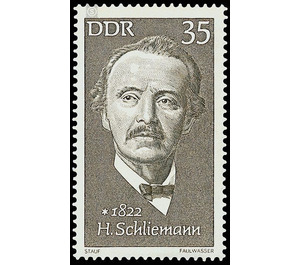Commemorative stamp series - Germany / German Democratic Republic 1972 - 35 Pfennig
Theme: Calender
| Country | Germany / German Democratic Republic |
| Issue Date | 1972 |
| Face Value | 35.00 |
| Color | brown |
| Perforation | K 14 |
| Printing Type | Typography |
| Stamp Type | Postage stamp |
| Item Type | Stamp |
| Chronological Issue Number | 1476 |
| Chronological Chapter | GER-DDR |
| SID | 556226 |
| In 23 Wishlists | |
Important Personalities, Edition 1972 The Ministry of Posts and Telecommunications of the German Democratic Republic publishes five special postage stamps with illustrations of important personalities. No special first-day cover envelope 35-pfennig value Heinrich Schliemann Heinrich Schliemann was born on January 6, 1822 in Neubukow / Mecklenburg. He received his first education in Neustrelitz. After five years of commercial apprenticeship in Fürstenberg he was enlisted in a ship destined for South America, but was forced after a shipwreck, first to accept a subordinate commercial position in Amsterdam. In 1846 he was sent to Petersburg for his knowledge of the Russian language, which he had acquired by self-study. There he founded his own trading company in 1847. In addition to his work, he did intensive language studies. (During his life he learned Russian, English, French, Swedish, Polish, Ancient Greek, New Greek and Latin.) To riches he traveled to Europe, Syria and Egypt, came in 1859 for the first time to Greece, undertook in 1864 a world tour and settled in Paris in 1866. Here he drove - inspired by Homer - extensive archaeological studies, and here was his plan to find the ancient Troy. He first went to the classical soil of ancient Ithaca, then turned to the coast of Asia Minor, where he suspected on the hill of Hissarlik the site of ancient Troy, which must have been more than 4,000 years old, and on the Homer's "Iliad" ten years of war between Greeks and Trojans had been waged. In 1870 Schliemann began - at his own expense - the first excavations, which were completed in 1882. They yielded a great yield. The excavations at Mykenä, the city of Agamemnons, which he first began in 1876 in the Acropolis near the famous Löwentor, gave even greater results. At the castle of Mycenae he discovered in deep layers a large number of tombs containing precious jewelery, weapons and even skeletons. In Ithaca in 1878 he resumed his earlier excavations and discovered on the mountain of Aktos the remains of an ancient city of kyklopischer type. In the following years, the discoveries of the so-called Treasury of Minya in Orchomenos and (1884/85) followed the exposure of the Palace of the Kings of Tiryus on the Acropolis. In 1888 he continued the excavations in Mycenae. Schliemann was actively supported in his work by his wife, a Greek, and scientifically advised by Wilhelm Dorpfeld. Close relations existed among others. also between Schliemann and Rudolf Virchow, who participated in excavations of Schliemann in Troy and evaluated them anthropologically. Precious pieces of the excavations are located in the Mycenaean Museum in Athens. Part of his collections, whose sole owner he became by paying compensation to the Greek government, is located in museums of the capital of the GDR, Berlin. They are carefully maintained and made accessible to the people. Heinrich Schliemann received an honorary doctorate from the University of Rostock in 1879, and in 1881 became honorary citizen of the city of Berlin. Heinrich Schliemann died on 27 December 1890 in Naples.


